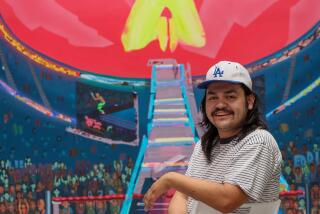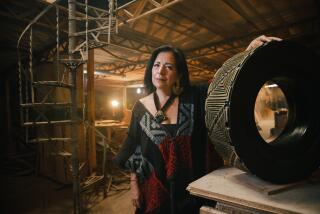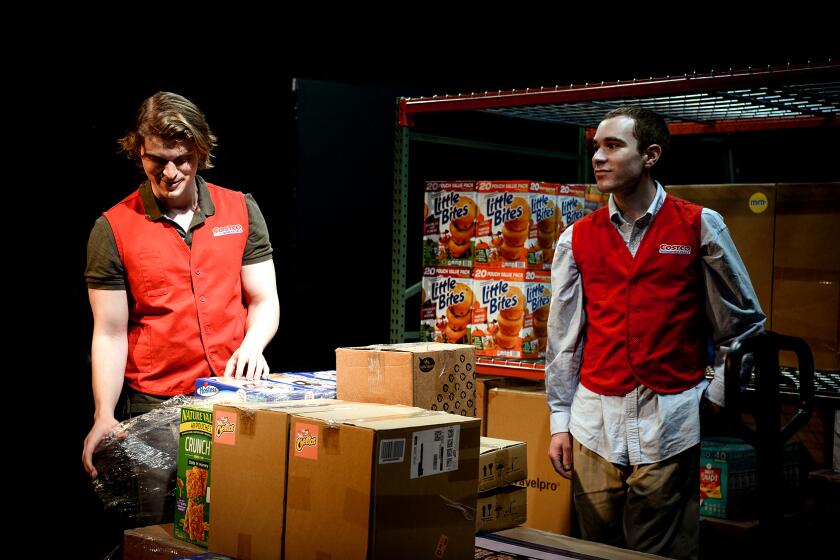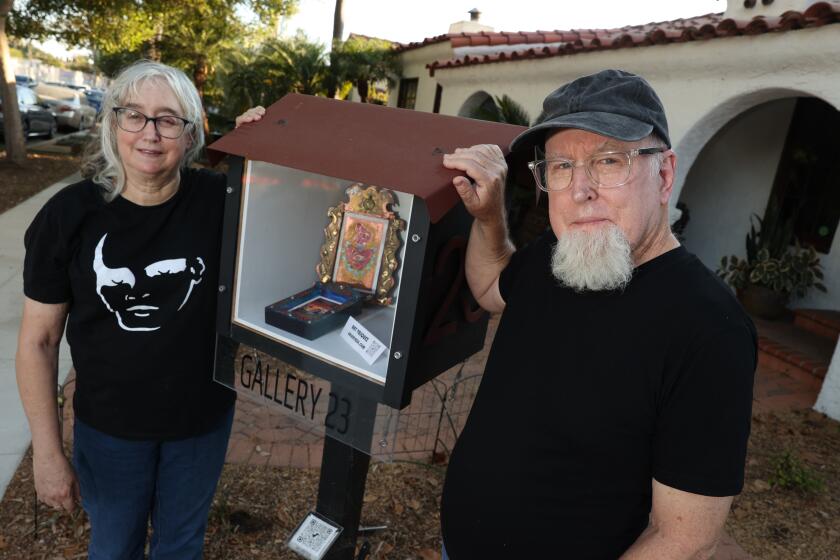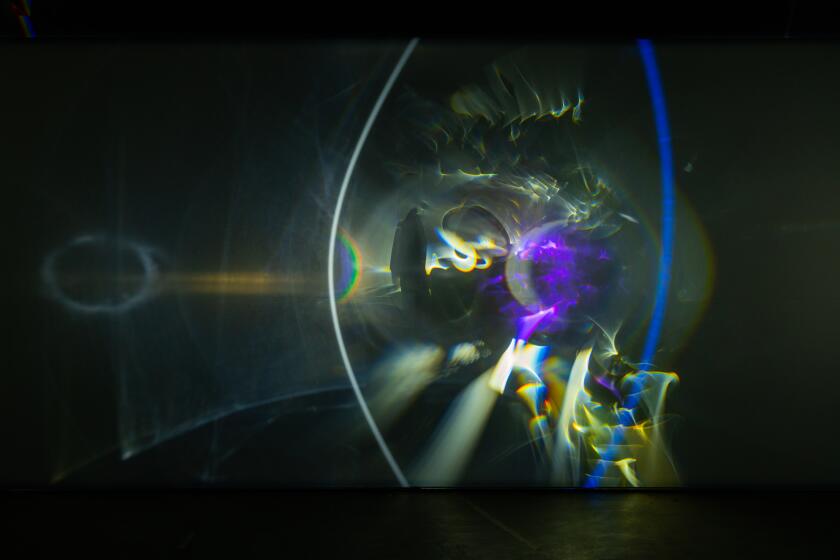Mural memorializes Ventura’s Tortilla Flats
It took just one month for a new freeway mural in Ventura to be hit by graffiti. The tagger was considerate, however, taking pains not to mar the piece, which commemorates a neighborhood destroyed in the 1950s to make way for the 101 Freeway. Instead of writing directly on the artwork, the tagger left a message on the back of an adhesive bandage, which was then applied as carefully as a mother treating a scrape on a child.
The tagger had targeted one of the historic photographs used in the mural to celebrate the displaced residents of Tortilla Flats, a lively, multieth- nic neighborhood on Ventura’s west side, just north of Surfers Point. Almost forgotten, many of the former residents are now depicted larger than life in a series of painted panels on a steel grid under the Figueroa Street overpass, between the old mission and the ocean. The neighborhood snapshots, some of which inspired the paintings, are ingeniously mounted on colorful boards and scattered throughout the work, which lines both sides of the street.
One of the pictures shows the 1948 graduating class of Holy Cross, the Catholic school next to Mission San Buenaventura. The tagger’s bandage was placed like a label under one of the girls in the picture with these words in tiny letters: “Me, graduated at 16 years old.”
Telling the story
The pride of that former student, who would now be 76, is the secret of the success of the Tortilla Flats mural, a collaboration between Ventura-based artists MB Hanrahan and Moses Mora. In re-creating and exalting the lost history of this humble neighborhood, the artists touch a universal human yearning for family roots and a sense of place.
“I use the freeway, so I can’t say I’m anti-freeway,” says Hanrahan, formerly of Los Angeles. “But if something comes in, something else is lost. A person. A life. A name. A neighborhood is gone. And that’s what we have to recognize. Every human being has a story.”
“We wanted to do this in their lifetime,” adds Mora, who coordinated the research into the neighborhood where he was born in 1949, shortly before it was paved over. “Pretty soon, they won’t be around anymore to talk to.”
This is the second incarnation of the Tortilla Flats project, originally conceived by the artists in 1993. An earlier version was painted on a 500-foot stretch of a wall just a stone’s throw from the current site. It was on display until 2000, when it fell into disrepair and the artists took it down.
But they knew they had touched a deep nerve. At that time, strangers would pass by and watch with wonder as images from their past took shape. Kids floating in a raft down the river. The Gibson’s market offering “Bar-B-Q in the Basket.” And the Green Mill Ballroom, which featured performers such as Chuck Berry and Lalo Guerrero.
One woman provided a photograph of her father who was killed during World War II, and the artists, as a tribute to his sacrifice, painted him into a portrait of surviving soldiers based on a different photograph. Then there was the elderly man who asked that he be figured into a panel showing “Salad Bowl Curve,” where produce trucks often spilled over in front of the city jail, because he was proud to have been a trusted inmate allowed out to help pick up the mess.
The community enthusiasm impressed city officials, who commissioned Hanrahan and Mora for $36,000 to reprise the project. Funded from its public arts budgetLalo Guerrero, the mural is part of a larger effort to encourage pedestrians to walk between downtown and the beach.
“I guess it’s human nature for us to want to remember our collective past,” says Denise Sindelar, Ventura’s public arts supervisor. “At some level everybody can remember a favorite childhood haunt that’s not there anymore.”
As a team, Hanrahan and Mora are something of an odd couple. I got a glimpse of their contrasting personalities this week when they joined me for lunch, sitting side by side in a Mexican restaurant near their studio in the Bell Arts Factory on Ventura Avenue.
Complementary traits
Hanrahan, 49, is a fast talker with explosive gestures and a sharp tongue. She sports bleached dreadlocks and denim overalls with Pooh Bear on the front and Frida Kahlo peeking out from between the suspenders. She grew up in Woodland Hills, daughter of the late Jack Hanrahan, an Emmy Award-winning comedy writer who worked on “Get Smart” and “Rowan & Martin’s Laugh-In.” She earned an MFA in sculpture from Humboldt State and later painted the exterior of the Wolfgang Puck Cafe at Universal CityWalk, in addition to creating props for films such as “Hancock” and “The Flintstones.”
Mora, 59, who is part Mexican and part Apache, never formally studied art. His father was a construction worker who moved to Tortilla Flats from New Mexico after World War II. Mora served in an Army artillery unit in Vietnam, got hooked on drugs and “came back rather troubled and confused,” spending time in and out of jail. He became a community organizer and says he discovered art through the Chicano and American Indian movements. Long since sober, he exudes a laid-back vibe, his hair tied in a braid that hangs below his waist.
“What we have in common is our art-ivism,” says Hanrahan, who also has kicked a drug habit. “We both have this hard-core commitment to community.”
The artists were surprised to learn that the county’s history museum had no information on record of Tortilla Flats. ever existing -- “no pictures, no documentation, no nothing!” So they set about doing their own research, tracking down residents and their offspring from the area’s 100 or so families, who were predominantly Mexican American but also included African Americans, Chumash Indians and white Dust Bowl refugees concentrated in a trailer park. Only three houses still stand, Mora says, with most residents dispersing throughout the city and losing touch.
But their community spirit survived. The artists’ effort led to the creation of the Tortilla Flats and Friends Reunion Committee, which holds barbecues and dances. “The average person can make history,” Hanrahan says. “They don’t just have to take the history that’s given to them.”
More to Read
The biggest entertainment stories
Get our big stories about Hollywood, film, television, music, arts, culture and more right in your inbox as soon as they publish.
You may occasionally receive promotional content from the Los Angeles Times.
